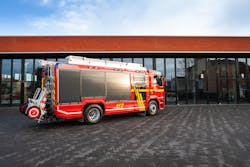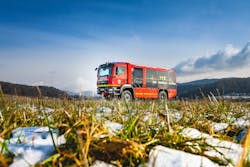Rosenbauer Celebrates 25 Years of AT Fire Apparatus on the Streets
In AT – the acronym stands for Advanced Technology and a success story spanning three generations. Twenty-five years ago, the Rosenbauer AT first saw the light of day, giving a resounding answer to the question of what a powerful, reliable and safe municipal fire-fighting vehicle should look like. Improved with each generation and supplemented by innovative technologies, the AT now embodies the technological standard of municipal firefighting like no other vehicle. It's considered the master of its class, and a standard of quality and reliability. It is fitted with high-quality, electronically controlled extinguishing technology and all of its essential functions can be operated intuitively and safely. It protects the crew during the journey and at the scene of the emergency, and is one of the first firefighting vehicles in the world to have been created in collaboration with professional designers and to have had international design awards bestowed upon it.
How it all began
The idea for the AT was born on a notepad. What a group of bright minds scribbled on those pieces of paper 25 years ago was supposed to revolutionize the appearance and construction of firefighting vehicles. There was nothing reminiscent of the vehicles they had built to date, not a single bolt stayed in the same place. Those creative engineers took ideas from the skiing, yachting and aircraft industries, and developed a completely new and pioneering firefighting vehicle with new materials (aluminium composite materials instead of steel sheets), with a completely new body concept (ribbed construction instead of a planked framework structures) and new manufacturing technologies (gluing instead of welding).
Lightweight construction changed everything
The Rosenbauer AT established the era of lightweight construction of firefighting vehicles. For the first time, the entire structural volume could be used for the payload, because the partition walls required for the framework structure were eliminated. Due to the lower weight (aluminium), higher loading capacities could be achieved, facilitating the installation of larger volume water/foam tanks, more complex pumping units, or extensive stowage systems. The superstructures were now glued and screwed, making them much stiffer and less prone to twisting, and also having a positive effect on driving behaviour. In addition, the lightweight aluminium construction put an end to the issue of corrosion.
The trademark
Even back then, a trademark was already a hallmark of the unmistakable character of the Rosenbauer AT and remains one of its most important identity characteristics to this day: the continuous vehicle profile, with the crew cab being integrated into the body. This occupies much less space than an original twin cabin, which is usually tilted with the driver's cab, and can also be better tailored to the individual needs of fire departments (SCBA holders, storage spaces, shelves, ...). Another advantage of the cab integrated into the body is the continuous roof surface, which can be optimally utilised for loading purposes and safely walked on. The interlocking connection of the driver's cab and crew cab into the body also allowed dynamic driving improvements to be made.
Electronics are coming
The next big development step followed in 2002: the CAN bus was added to the AT program, the vehicle family "electronified", and thus fundamentally changing the way in which the technology of a fire-fighting vehicle is operated. The vehicles can now be controlled via modern displays, and extinguishing technology has been automated to such an extent that operators are now able to also perform other activities during an operation. As a result, the Rosenbauer control system was continuously expanded so that portable pumps, power generators and other devices were also available with the same operating principle.
Safety first From the very beginning , the safety of the crew was a central topic in the development of the AT, and it was significantly increased with the patented Rosenbauer rotating steps, which first became available on the second generation of the vehicle. It rotates with the opening of the crew doors, and locks automatically in every door position, so that emergency personnel always have a secure footing when entering or exiting the cab, even in very cramped spaces. Over the years, the safety of an AT's occupants has also been greatly improved. All seats in the crew cab are now equipped with seat belts and, on request, a complete rollover airbag system with belt tensioners can be installed for the outer seats.
Stable handling As far as driving safety is concerned, the AT has also set new benchmarks. The entire vehicle has been structurally stiffened. The combination of a low centre of gravity and direct mounting of the superstructure on the chassis results in particularly stable driving characteristics. Through this, the AT exhibits safe handling both on difficult terrain and during sudden steering turns.
Ready for use at the push of a button
Once it has arrived at the scene of the emergency, the AT is secured at the push of a button. The scene arrival switch can be used to automatically switch on the hazard lights and front flashing lights, the traffic guidance system at the rear, and the scene lighting, and the built-in pump can be set to run at a predefined speed, the light mast is also extended to a pre-set height.
Fully LED-equipped
In 2011, the next major development step followed, with the introduction of LED lighting and illumination technology. LED technology is now installed throughout the vehicle, from the floor contour lights to the equipment compartment lighting, in order to achieve daylight-like initial illumination even in poor visibility conditions or at night. The crew cab is completely glare-free and homogeneously illuminated, so that the crew can prepare for the operation in peace.
Central water axis
The central water axis was also implemented in this generation; yet another innovation from Rosenbauer which was to become a trend-setting feature for firefighting vehicles. The central water axis automatically takes over the logical distribution of the water to where it is needed in the vehicle: to the tank, to the pump, or to both at the same time. Thus, the extinguishing water supply of the vehicle, whether suction or supplied, is continuously secured.
Environmentally friendly engines
From 2015, Euro 6 engines were introduced to the AT family. The premium vehicle thus met the latest emissions standards. Extinguishing water tanks are now made of polypropylene, making them suitable for the transport of drinking water and meaning that they can be almost completely recycled. Step-by-step, glass fibre reinforced plastic parts are being replaced by alternative materials.
Enormous variability
Today, the AT family consists of dozens of basic types and hundreds of additional options which can be selected. It includes firefighting vehicles from 10 to 20 metric tons total weight, all of which comply with current international firefighting standards. The vehicles can be equipped with water tanks of up to 5,500 liters, and built-in pumps with equivalent output per minute. Together with high-performance high pressure pumps, foam proportioning systems, rapid intervention systems and high-performance turrets, they form perfectly coordinated and fully integrated extinguishing systems for every firefighting operation. To ensure the greatest possible payload variability, a sophisticated ergonomic stowage system has been developed, which includes space-saving hose magazines, as well as rotating shelves, pull-out trays, swivelling hygiene boards, and ladder lowering systems. This means that any free space in the vehicle can be used optimally and according to the wishes of the fire departments. A uniform colour logic - all operational and graspable devices within the vehicle are marked with the signal colour orange - supports the fire departments in the safe and rapid removal of equipment from the vehicle.
For every fire department
Although the basic concept of the AT is aimed at the standardized firefighting markets of Austria, Germany and Switzerland, it is at home on all continents. Vehicles from the AT family have so far been delivered to over 50 countries around the globe, and are in service with volunteer fire departments, as well as with urban professional and plant fire departments. They usually serve to provide the central, multifunctional tools required for everyday municipal firefighting, but can also be equipped with special extinguishing technology and converted into high-quality industrial and airport firefighting vehicles.
About The Rosenbauer Group
Rosenbauer is an internationally active corporate group that is a dependable partner of the firefighting community all over the world. The company develops and produces vehicles, firefighting systems, fire & safety equipment and telematic solutions for professional, industrial and volunteer fire services, as well as installations for preventive fire protection. In more than 100 countries, Rosenbauer is the largest fire equipment provider in the world with revenues of about € 910 million and more than 3,600 employees.

